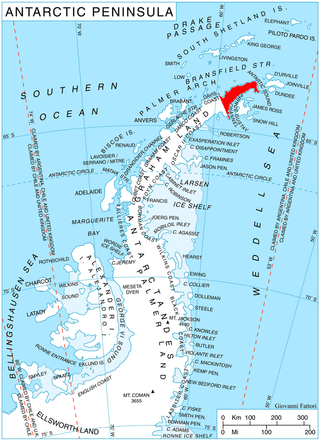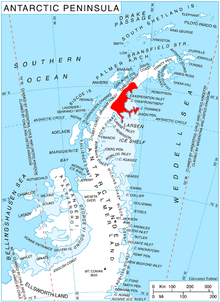The Churchill Mountains are a mountain range group of the Transantarctic Mountains System, located in the Ross Dependency region of Antarctica. They border on the western side of the Ross Ice Shelf, between Byrd Glacier and Nimrod Glacier.

Lambert Glacier is a major glacier in East Antarctica. At about 80 km (50 mi) wide, over 400 km (250 mi) long, and about 2,500 m (8,200 ft) deep, it is the world's largest glacier. It drains 8% of the Antarctic ice sheet to the east and south of the Prince Charles Mountains and flows northward to the Amery Ice Shelf. It flows in part of Lambert Graben and exits the continent at Prydz Bay.

The Prince Charles Mountains are a major group of mountains in Mac. Robertson Land in Antarctica, including the Athos Range, the Porthos Range, and the Aramis Range. The highest peak is Mount Menzies, with a height of 3,228 m (10,591 ft). Other prominent peaks are Mount Izabelle and Mount Stinear. These mountains, together with other scattered peaks, form an arc about 420 km (260 mi) long, extending from the vicinity of Mount Starlight in the north to Goodspeed Nunataks in the south.
Surveyors Range is a 30 miles (48 km) long mountain range in the Churchill Mountains of Antarctica.
Penck Glacier is a small glacier flowing northward along the west side of Bertrab Nunatak to Vahsel Bay. Discovered by the German Antarctic Expedition, 1911–12, under Wilhelm Filchner, who named this feature for German geographer Albrecht Penck.
Explorers Range is a large mountain range in the Bowers Mountains of Victoria Land, Antarctica, extending from Mount Bruce in the north to Carryer Glacier and McLin Glacier in the south. Named by the New Zealand Antarctic Place-Names Committee (NZ-APC) for the northern party of New Zealand Geological Survey Antarctic Expedition (NZGSAE), 1963–64, whose members carried out a topographical and geological survey of the area. The names of several party members are assigned to features in and about this range. All of the geographical features listed below lie situated on the Pennell Coast, a portion of Antarctica lying between Cape Williams and Cape Adare.

Aitkenhead Glacier is a 10-mile (16 km) long glacier flowing east-southeast from the Detroit Plateau, Graham Land, into Prince Gustav Channel. It was mapped from surveys by the Falkland Islands Dependencies Survey (FIDS) (1960–61), and named by the United Kingdom Antarctic Place-Names Committee for Neil Aitkenhead, a FIDS geologist at Hope Bay (1959–60).
Jupiter Glacier is a glacier on the east coast of Alexander Island, Antarctica, 10 nautical miles (19 km) long and 5 nautical miles (9 km) wide at its mouth, which flows east into George VI Sound to the south of Ablation Valley. It was first photographed from the air on November 23, 1935, by Lincoln Ellsworth and mapped from these photos by W.L.G. Joerg. It was roughly surveyed in 1936 by the British Graham Land Expedition, and was named for the planet Jupiter by the Falkland Islands Dependencies Survey following their surveys in 1948 and 1949.

Jorum Glacier is a glacier draining the southeast slopes of Forbidden Plateau, and lowing east into Exasperation Inlet, just north of Caution Point, on the east coast of Graham Land, Antarctica. It was surveyed by the Falkland Islands Dependencies Survey in 1947 and 1955. The UK Antarctic Place-Names Committee name alludes to the punchbowl shape of the head of the glacier, a "jorum" being a large drinking bowl used for punch.
Kovacs Glacier is a glacier on the southeast side of Lexington Table, flowing east-northeast into Support Force Glacier in the Forrestal Range of the Pensacola Mountains, Antarctica. It was named by the Advisory Committee on Antarctic Names in 1979 after Austin Kovacs, who was leader of the 1973–74 United States Antarctic Research Program – Cold Regions Research and Engineering Laboratory survey party in this area, and also worked in the McMurdo Sound area.
Frostman Glacier is a broad, low gradient glacier discharging into the south side of Hull Bay just west of the Konter Cliffs, on the coast of Marie Byrd Land, Antarctica. It was mapped by the United States Geological Survey from surveys and U.S. Navy air photos, 1959–65, and was named by the Advisory Committee on Antarctic Names for Thomas O. Frostman, a meteorologist at Plateau Station, 1968.

Evans Glacier is a gently-sloping glacier 15 nautical miles (28 km) long and 4 nautical miles (7 km) wide, draining the southeast slopes of Travnik Buttress eastwards between Rugate Ridge and Poibrene Heights to flow into Vaughan Inlet on the east coast of Graham Land, Antarctica. It was discovered by Sir Hubert Wilkins in an aerial flight, December 20, 1928, and named "Evans Inlet" by him for E.S. Evans of Detroit. A further survey by the Falkland Islands Dependencies Survey in 1955 reported that this low-lying area is not an inlet, but is formed by the lower reaches of Hektoria Glacier and the feature now described.
Garfield Glacier is a glacier, 6 nautical miles (11 km) long, flowing between the Peden Cliffs and Cox Point to the east side of Hull Bay on the coast of Marie Byrd Land, Antarctica. It was mapped by the United States Geological Survey from surveys and U.S. Navy air photos, 1959–65, and was named by the Advisory Committee on Antarctic Names for Donald E. Garfield, who participated in deep core drilling activities at Byrd Station, 1967–68.
Goodwin Glacier is a glacier flowing west into Flandres Bay southward of Pelletan Point on the west coast of Graham Land, Antarctica. It was charted by the Belgian Antarctic Expedition under Gerlache, 1897–99. It was named by the UK Antarctic Place-Names Committee in 1960 for Hannibal Goodwin, an American pastor who invented the first transparent nitrocellulose flexible photographic roll-film in 1887.

Hugi Glacier is a glacier flowing northward into the head of Holtedahl Bay southwest of Rasnik Peak, on the west coast of Graham Land, Antarctica. It was charted by the British Graham Land Expedition under John Rymill, 1934–37, and was named by the UK Antarctic Place-Names Committee in 1959 for Franz Joseph Hugi, a Swiss teacher who was called the "father of winter mountaineering," and was author of two pioneer works on glacier phenomena.
Starshot Glacier is a glacier 50 nautical miles (90 km) long that flows through the Churchill Mountains to enter the Ross Ice Shelf in Antarctica.
Robb Glacier is a glacier about 40 nautical miles (70 km) long that flows through the Ross Dependency to enter the west coast of the Ross Ice Shelf in Antarctica.
Rubey Glacier is a broad, heavily crevassed glacier of West Antarctica flowing north to coalesce with the west side of Hull Glacier eastward of Mount Giles, near the coast of Marie Byrd Land. Mapped by United States Geological Survey (USGS) from surveys and U.S. Navy air photos, 1959–65. Named by Advisory Committee on Antarctic Names (US-ACAN) for Captain Ervin B. Rubey, U.S. Navy, Commander of Antarctic Support Activities at McMurdo Station, summer 1969–70.

Leay Glacier is a glacier flowing northwest into Girard Bay to the west of Hotine Glacier, on Kyiv Peninsula, on the west coast of Graham Land, Antarctica. It was first charted by the French Antarctic Expedition, 1908–10, under Jean-Baptiste Charcot, and was named by the UK Antarctic Place-Names Committee for Petra Searle of the Directorate of Overseas Surveys, who has contributed to the work of mapping the Antarctic Peninsula area.

Minzuhar Glacier is the 6.5 km long and 3 km wide glacier on Oscar II Coast, Graham Land in Antarctica situated southwest of Punchbowl Glacier and northeast of Jorum Glacier. It is draining from the southeast slopes of Forbidden Plateau southeastwards between Metlichina Ridge and Yordanov Nunatak to flow into Borima Bay north of Furen Point.






